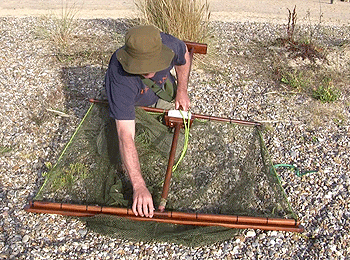Shrimping along the shoreline

Living on the coast has many benefits, including the fresh sea air, which is normally a few degrees cooler than inland, and of course, some fantastic beaches. I am spoilt for choice where I live, having both sand and shingle beaches on which to exercise my dogs, Bella and Millie. Walking on the beach is as good for their feet as it is for lifting my soul. Losing myself among the surf on my daily walks, I regularly pass the retired and redundant fishermen, a band of men who still congregate outside an old fish seller’s hut on top of a tiny cliff.
I have walked and hunted this mixture of sand and shingle-laden dunes for more than a quarter of a century, but apart from two men netting from a small boat, I cannot recall anyone other than my colleague Steve Taylor harvesting anything from the sea off Pakefield beach without using a rod and line.
Steve had been out one night recently, in a scene reminiscent of a time when those fishermen were mere boys and the land behind my house wasn’t lost to the sea. Armed with nothing more than a push-net and a cartridge bag, he harvested a few pints of shrimp only a stone’s throw from my house. I was intrigued by his tales, and despite being a landlubber with an aversion to getting wet, I foolishly agreed to go out shrimping with him at the next opportunity.
Finding my sea legs
Steve and his wife Marie are the archetypal opportunists when it comes to foraging. Whether fur, feather or fin, leaf, bulb or fungus, they always have a method, a recipe and a free meal to show for their convictions. But would they be able to coax me into the sea above my ankles? I had my doubts.
Steve made his push-net in a similar way to how he imagined the late television presenter Jack Hargreaves would have done so. Trawling through his cluttered shed, he found an old carp-landing net, a few broom shanks and some cable ties (which, like duct tape, is an invention I’m sure Jack would have appreciated). A fruitful few hours spent sawing, thumping, snipping — and swearing — resulted in a shrimp push-net of some quality. This flat-pack net was designed to be carted about easily on a pushbike, the mode of transport used when shrimp netting was last in vogue.
The wildfowlers I know tell me just how invaluable to any sea-related activity the tide table is. The sea can quickly become a killer if the foolhardy ignore the tide table. In need of a favourable ebb tide for our outing, we waited until 7.15pm. The period between high and low tide is when the water flows away from the shore, exposing the sand and its inhabitants. As we walked towards the sea, a few people craned their necks to watch us, but that may have had more to do with the sight of our spindly white legs than what we were carrying.
Once the push-net was assembled, Steve picked it up and stomped off towards the sea with intent. He was wearing protection on his feet to avoid the danger of being stung by a weever fish, which would undoubtedly have curtailed
our foray and dampened his enthusiasm.
Experience bequeaths that the secret of a push-net is the angle of the scraper and the way it caresses the seabed. With the sea lapping just above his knees, Steve pushed his net along, and anything lurking on or just below the sand was immediately caught. Checking it every 50 or so yards, Steve relieved his green net of any non-target species, such as jellyfish and countless crabs, returning them unharmed to the sea, while any shrimp were carefully placed inside his cartridge bag.
After 15 or so minutes, it was my turn to try out this unfamiliar mode of netting. Cautiously, I waded to the dizzy depths of my knees to take over. Pushing the net for one sweep was a lot harder than I had imagined, especially as my long stride caused me almost to trip over the flowing net several times. Though I caught a few shrimp, I was as uncomfortable in the sea as I am in the air, so I passed the net back to Steve.
A modest catch
Now watching from the sanctuary of the shoreline, I pondered how time-consuming a process it is, as well as how dependent we are on the moon, wind and tides for our shrimp. The UK consumes some 50,000 tons of shrimp per year, but I don’t expect Steve, Marie and I will go into business selling Pakefield shrimps any time soon, though Steve’s harvest of a pint-and-a-half of large shrimp in just 20 or so minutes was pretty impressive.
Back on terra firma, to affirm their hunter-gatherer ethos, Marie boiled up some water on the camping stove, and once Steve had finished rinsing off the shrimp, she washed them again with freshwater before cooking them for about a minute until they were a reddish-brown colour and ready to eat.
This simplest of harvests illustrated that, while shrimp are relatively easy to catch, and quick and easy to cook, the real skill is in peeling them. This is unquestionably an art that must be mastered. As we watched Marie’s nifty handwork in releasing the crustaceans of their inedible armour, I realised that many would-be hunters’ moral dilemma isn’t in how we harvest our game, but what we do with it once it is harvested. We need to remove the blinkers and learn to prepare and cook the bounty we have caught and not let anything go to waste.








